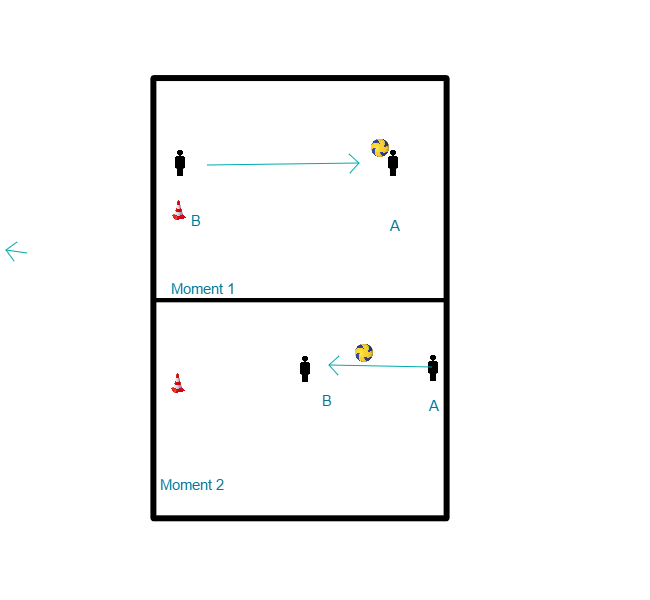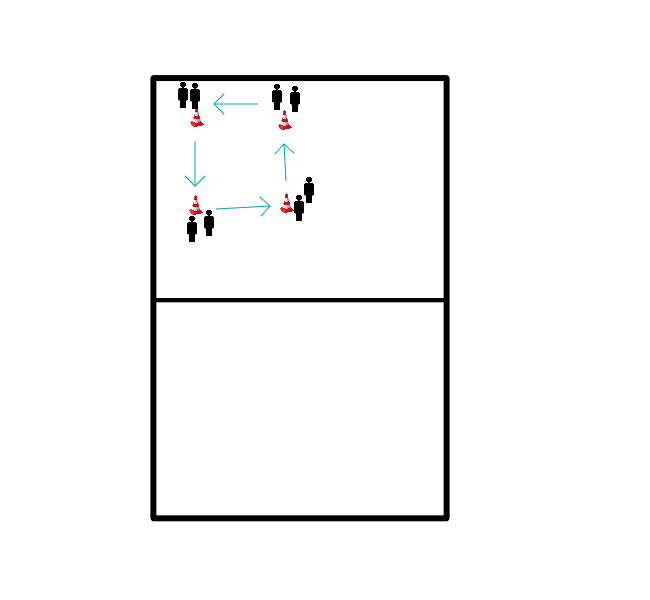Korfball drills for technique general
 2 teams. Per pair 1 ball and 1 pawn. Player A stays on his spot. Player B starts with the pawn, which is about 10 meters away. Player B runs to player A. Player A throws (with 1 hand) the ball to player B. Player B keeps running until he has caught the ball and then stops. B throws the ball back and runs to the pawn to start the exercise again. after 10x change.
2 teams. Per pair 1 ball and 1 pawn. Player A stays on his spot. Player B starts with the pawn, which is about 10 meters away. Player B runs to player A. Player A throws (with 1 hand) the ball to player B. Player B keeps running until he has caught the ball and then stops. B throws the ball back and runs to the pawn to start the exercise again. after 10x change.
Mission
There are all pawns 3x3. Each group stands behind a pawn 10 metres away. Each group gets its own colour caps. Then the first group runs to the caps that are further away and tries to get 3 in a row as fast as possible. At the sign of the trainer the next person can put down a cap.
Mission
We divide the team in two equal groups and the two groups stand each behind a pylon.
The two groups stand behind a pylon and at a distance of 10 metres they make a shot from the pylon which is 2 metres away from the pylon. When the children have scored, they may continue to the pylon behind the post at a distance of 5 metres.
Finally they run 3 circles around the pylon and run back to their line.
Then the next one in line may start.
Variation:
Instead of a shot, they make a through ball.
Instead of making a shot from 2 metres, they make a shot from 4 metres.
Make 5 rows of hats, each row has its own colour.
Let the players jog between the hats. After about 10 seconds call out a colour and the players have to sprint to the hats with the correct colour. The last player to reach the hat gets a penalty point. 5 penalty points means the player has to do 5 push-ups and then starts again at 0 penalty points.
party with the whole group
You put four pawns in a square with a distance of 8 metres. Then you let the children make pairs. The children may take turns rolling the dice. You have three different rounds:
Round 1:
The children roll the dice. For example, if a group throws 4, each group must run 4 laps around the pawns.
Round 2:
The children first say who they are going to roll the dice for and then they get to roll passes. So they pick a group, say group 2 and roll the dice for that group.
Round 3:
The children first get to roll the dice and then they pick a group. This is almost always the most fun round. 
Everyone lies down on the floor like a plank, supporting themselves on their elbows with their legs extended. Then the children jump up and stretch all the way.
party with the whole group
 2 teams. Per pair 1 ball and 1 pawn. Player A stays on his spot. Player B starts with the pawn, which is about 10 meters away. Player B runs to player A. Player A throws (with 1 hand) the ball to player B. Player B keeps running until he has caught the ball and then stops. B throws the ball back and runs to the pawn to start the exercise again. after 10x change.
2 teams. Per pair 1 ball and 1 pawn. Player A stays on his spot. Player B starts with the pawn, which is about 10 meters away. Player B runs to player A. Player A throws (with 1 hand) the ball to player B. Player B keeps running until he has caught the ball and then stops. B throws the ball back and runs to the pawn to start the exercise again. after 10x change.
- 1 post less than number of shooters.
- As long as music is playing, players run in circles.
- When the music stops, they can take goal attempts.
- On each post a maximum of 2 attempts may be made.
- As soon as this is done. The attackers put the ball on the ground.
- Who scores first....
- through balls
- feint
- shots
Activity:
Number one;
Scoring 5 through-balls
Number 2;
1 lap around the whole field
Number 3;
scoring 10 short chances.
Number 4;
5 penalties.
Number 5:
4 goals from 5 meters
For each group they have to do each exercise in a certain order and then they write that order down and come to the trainer.
- The trainer puts a circle in the right place if an exercise is in the correct order.
- Put a cross through it if it is wrong.
Then the group continues with a different order and do the same as above
The groups will continue until they get the code right.
- There is someone with a ball under the pole, someone in front of the pole at shooting distance and someone at about 1.5/2 m from the shooter with his face towards the pole.
- The shooter chooses one side and gets the ball.
- The defender is only allowed to turn around when the ball is loose and must therefore respond properly.The defender may not try to block the ball into the pass, but may try to block the shot.
- This can be done as an extension








